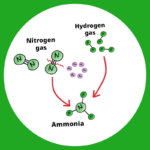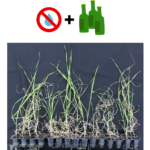Researchers at the RIKEN Center for Sustainable Resource Science (CSRS) in Japan have recently created a healthier form of starch in the cassava plant. Published in the scientific journal Plant Molecular Biology, the study shows how reducing levels of starch branching enzymes (SBEs) in cassava plants changes the composition of tapioca starch, making it more resistant to digestion and healthier for us to eat.
Most of the starch we eat comes from cereal crops like rice, corn, and wheat or tuber crops like potato and cassava. Starch contains two molecules—amylose and amylopectin. The difference between them is that amylose is a straight chain of glucose molecules connected end to end, while in amylopectin the chains branch out like a tree. The crops we eat differ in their relative amounts of amylose and amylopectin. For example, rice starch contains about 35% amylose (65% amylopectin), while cassava starch, commonly called tapioca, contains only about 17% amylose (82% amylopectin). Normal starch that includes branching amylopectin is easily digested by enzymes in saliva. That sounds good, but actually amylose and less-branched amylopectin are healthier because their structures can resist digestion. Instead of giving us unhealthy blood sugar spikes, resistant starch travels to our gut where it becomes food for all the good bacteria that live there and keep us healthy.
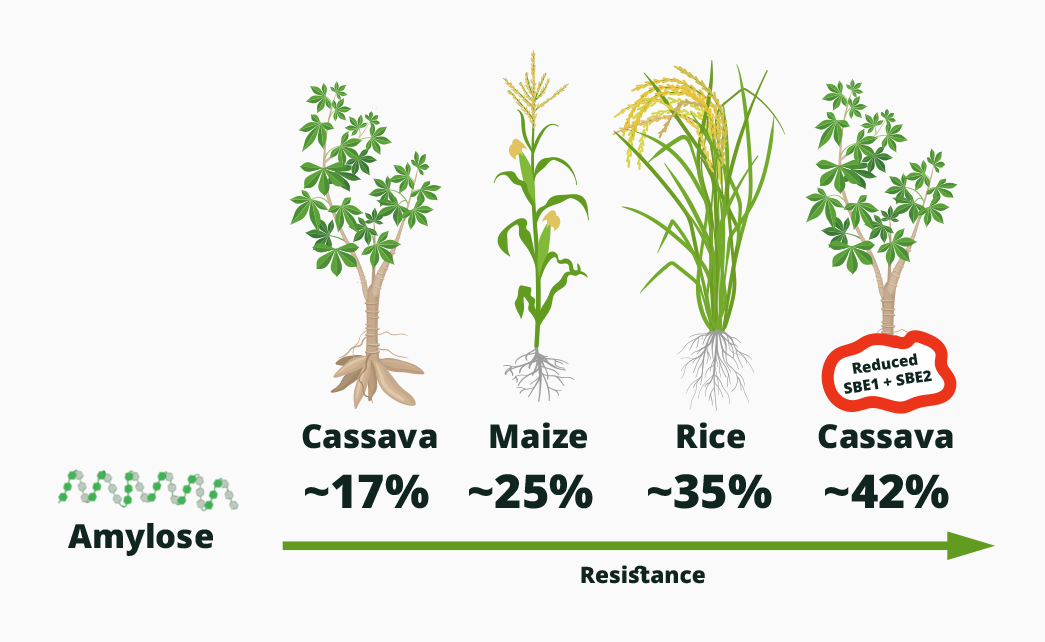
Typical percentage of amylose across common crops. More amylose makes starch more resistant to digestion, which makes it healthier. The new transgenic starch increased amylose content from about 17% to about 42%. This was accomplished by reducing the amount of Starch Branching Enzymes 1 and 2 (SBE1 and SBE2) by about 90% each.
The RIKEN CSRS team focused on the cassava plant because it is often overlooked, even though it is one of most import crops in tropical and subtropical regions. “By suppressing multiple genes one by one, we were able to increase the amount of resistant tapioca by about 63%.” says lead researcher Yoshinori Utsumi. “Not only will this starch improve intestinal function, but it will also improve blood sugar and insulin responsiveness.”
Resistant starch has two characteristics. The first is amylopectin with fewer branches and longer chains, making is harder to digest. The second is a lower percentage of amylopectin overall. To generate resistant starch, the researchers focused on the enzyme that helps create the branches in amylopectin. To create a branch, one chain of amylose must attach to the middle of another chain of amylose. Creating this bond requires starch branching enzymes (SBEs). The team reasoned that reducing this enzyme’s activity would be a way to generate resistant starch. Therefore, the first step was to identify the SBE genes in the cassava genome. Analysis revealed three SBE genes, with a few subtypes. SBE1 and SBE2a appear to be involved in making amylopectin in cassava leaves and roots, while SBE2c is only in the roots.
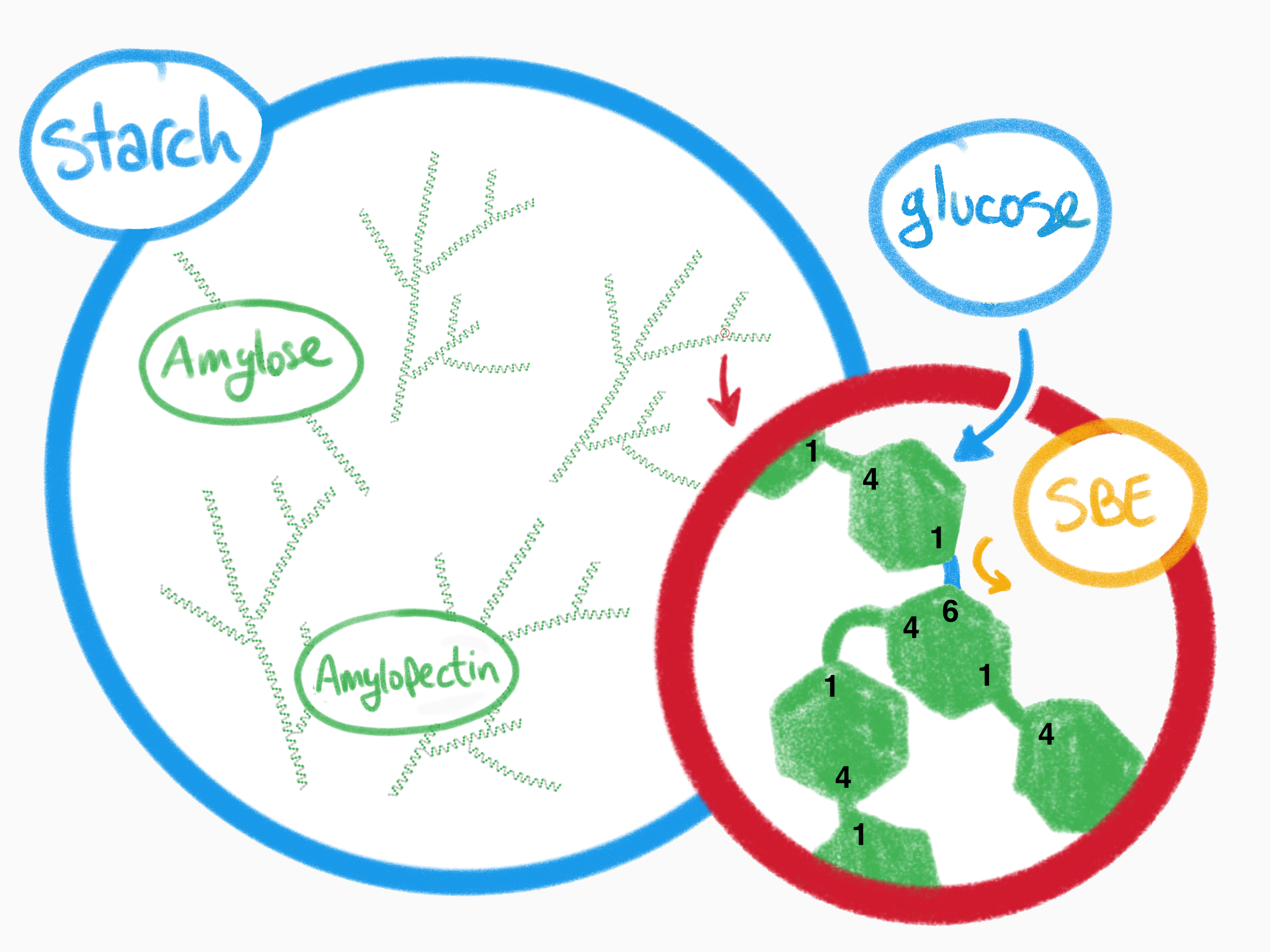
Composition of starch. All starch is composed of two molecules: amylose and amylopectin. Both comprise chains of glucose molecules, but while amylose is non-branching, amylopectin branches. Blue Circle: Schematic of typical starch in which the percentage of amylose is much lower than that of amylopectin (20% to 80% in this example). Red Circle: A close up of an amylopectin molecule just after a new branch is formed. The green bonds connect the glucose molecules end to end. These are called alpha 1-4 bonds because the carbon at location 1 on a glucose molecule bonds to the carbon at location 4 of another. A branch is formed when a glucose molecule bonds to the carbon at location 6 of another. Making this alpha 1-6 bond (blue bond) requires starch branching enzymes (SBEs).
Next, the researchers created several lines of transgenic cassava to compare with unmodified wild-type cassava. The most successful transgenic lines were those in which both SBE1 and SBE2 expression were reduced to about 10% of wild-type expression. Looking at the factors that increase starch resistance, the researchers found that although wild-type cassava contained about 17% amylose, the roots of two transgenic lines in which both SBE1 and SBE2 were reduced contained about 40% amylose. These lines also produced root amylopectin with fewer branches and longer chains. Overall, the percent of resistant tapioca starch rose from 0.4% to about 25%, a whopping increase of about 6300%, although the total amount of starch did decrease a little.
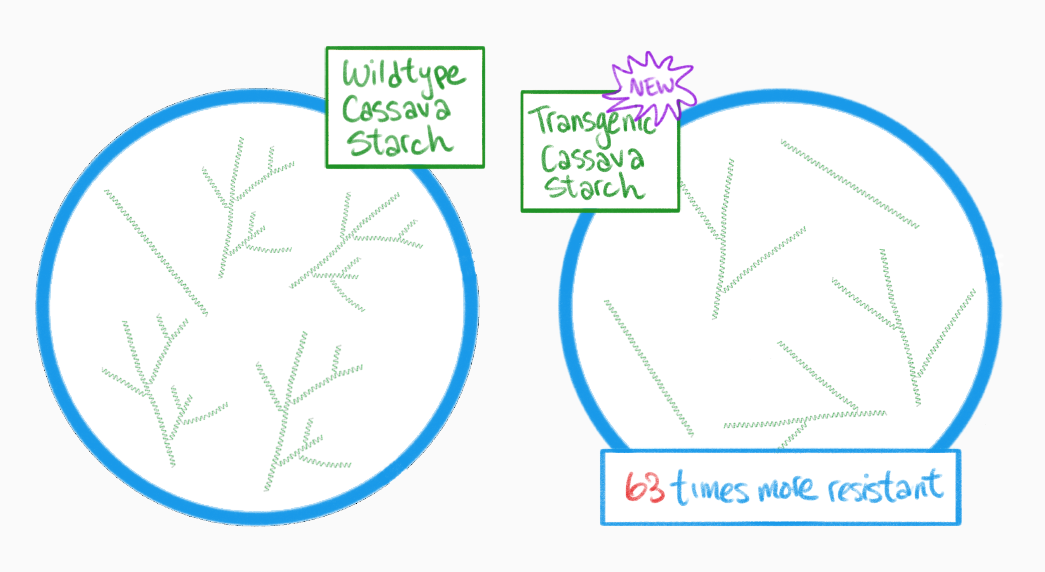
Composition of the new transgenic tapioca starch. Left: Schematic of wild-type tapioca (cassava) starch. Amylose content is about 17% (for simplicity, depicted here as 20%). Right: Schematic of the new transgenic tapioca starch. After reducing starch branching enzymes 1 and 2 by about 90% each, the resulting starch contained about 40% amylose, and the amylopectin contained fewer branches and longer chains. This led to starch that was 63 times more resistant to digestion, making it healthy than wild-type tapioca starch.
“In addition to advancing cassava molecular breeding, we hope that our findings will lead to more functional foods that improve human health,” says Utsumi. “Now that we have identified the cassava genes for molecularly more resistant starch, the next step will be to verify the effectiveness of these plants and the tapioca starch they produce.”
Most of the starch we eat comes from cereal crops like rice, corn, and wheat or tuber crops like potato and cassava. Starch contains two molecules—amylose and amylopectin. The difference between them is that amylose is a straight chain of glucose molecules connected end to end, while in amylopectin the chains branch out like a tree. The crops we eat differ in their relative amounts of amylose and amylopectin. For example, rice starch contains about 35% amylose (65% amylopectin), while cassava starch, commonly called tapioca, contains only about 17% amylose (82% amylopectin). Normal starch that includes branching amylopectin is easily digested by enzymes in saliva. That sounds good, but actually amylose and less-branched amylopectin are healthier because their structures can resist digestion. Instead of giving us unhealthy blood sugar spikes, resistant starch travels to our gut where it becomes food for all the good bacteria that live there and keep us healthy.
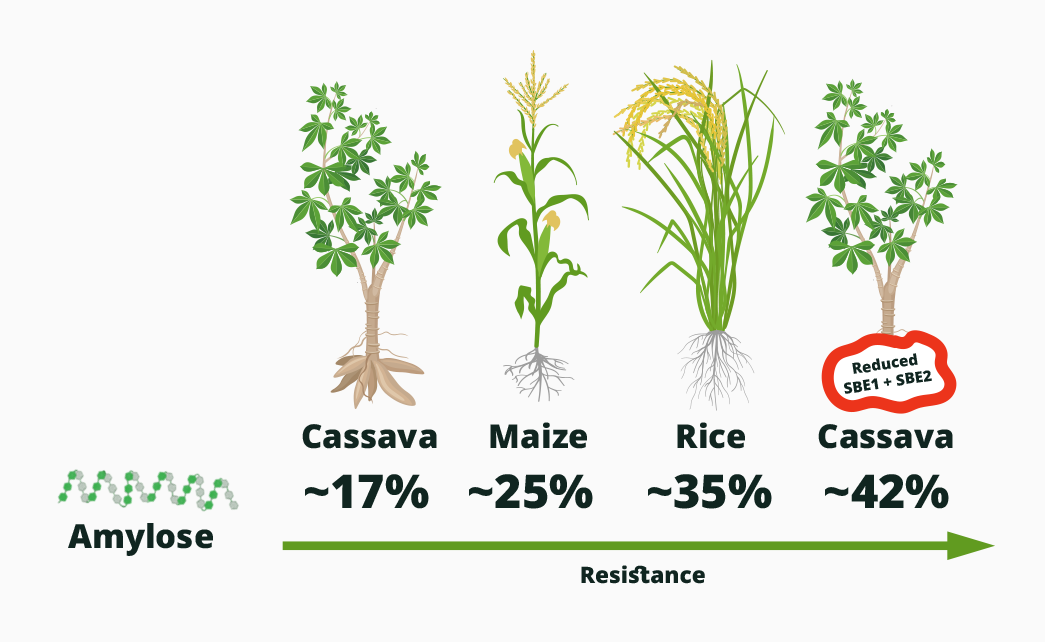
Typical percentage of amylose across common crops. More amylose makes starch more resistant to digestion, which makes it healthier. The new transgenic starch increased amylose content from about 17% to about 42%. This was accomplished by reducing the amount of Starch Branching Enzymes 1 and 2 (SBE1 and SBE2) by about 90% each.
The RIKEN CSRS team focused on the cassava plant because it is often overlooked, even though it is one of most import crops in tropical and subtropical regions. “By suppressing multiple genes one by one, we were able to increase the amount of resistant tapioca by about 63%.” says lead researcher Yoshinori Utsumi. “Not only will this starch improve intestinal function, but it will also improve blood sugar and insulin responsiveness.”
Resistant starch has two characteristics. The first is amylopectin with fewer branches and longer chains, making is harder to digest. The second is a lower percentage of amylopectin overall. To generate resistant starch, the researchers focused on the enzyme that helps create the branches in amylopectin. To create a branch, one chain of amylose must attach to the middle of another chain of amylose. Creating this bond requires starch branching enzymes (SBEs). The team reasoned that reducing this enzyme’s activity would be a way to generate resistant starch. Therefore, the first step was to identify the SBE genes in the cassava genome. Analysis revealed three SBE genes, with a few subtypes. SBE1 and SBE2a appear to be involved in making amylopectin in cassava leaves and roots, while SBE2c is only in the roots.

Composition of starch. All starch is composed of two molecules: amylose and amylopectin. Both comprise chains of glucose molecules, but while amylose is non-branching, amylopectin branches. Blue Circle: Schematic of typical starch in which the percentage of amylose is much lower than that of amylopectin (20% to 80% in this example). Red Circle: A close up of an amylopectin molecule just after a new branch is formed. The green bonds connect the glucose molecules end to end. These are called alpha 1-4 bonds because the carbon at location 1 on a glucose molecule bonds to the carbon at location 4 of another. A branch is formed when a glucose molecule bonds to the carbon at location 6 of another. Making this alpha 1-6 bond (blue bond) requires starch branching enzymes (SBEs).
Next, the researchers created several lines of transgenic cassava to compare with unmodified wild-type cassava. The most successful transgenic lines were those in which both SBE1 and SBE2 expression were reduced to about 10% of wild-type expression. Looking at the factors that increase starch resistance, the researchers found that although wild-type cassava contained about 17% amylose, the roots of two transgenic lines in which both SBE1 and SBE2 were reduced contained about 40% amylose. These lines also produced root amylopectin with fewer branches and longer chains. Overall, the percent of resistant tapioca starch rose from 0.4% to about 25%, a whopping increase of about 6300%, although the total amount of starch did decrease a little.

Composition of the new transgenic tapioca starch. Left: Schematic of wild-type tapioca (cassava) starch. Amylose content is about 17% (for simplicity, depicted here as 20%). Right: Schematic of the new transgenic tapioca starch. After reducing starch branching enzymes 1 and 2 by about 90% each, the resulting starch contained about 40% amylose, and the amylopectin contained fewer branches and longer chains. This led to starch that was 63 times more resistant to digestion, making it healthy than wild-type tapioca starch.
“In addition to advancing cassava molecular breeding, we hope that our findings will lead to more functional foods that improve human health,” says Utsumi. “Now that we have identified the cassava genes for molecularly more resistant starch, the next step will be to verify the effectiveness of these plants and the tapioca starch they produce.”
Further reading
Utsumi et al (2021) Suppressed expression of starch branching enzyme 1 and 2 increases resistant starch and amylose content and modifies amylopectin structure in cassava. Plant Mol Biol. doi: 10.1007/s11103-021-01209-w
Further reading
Utsumi et al (2021) Suppressed expression of starch branching enzyme 1 and 2 increases resistant starch and amylose content and modifies amylopectin structure in cassava. Plant Mol Biol. doi: 10.1007/s11103-021-01209-w



